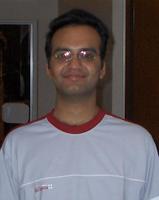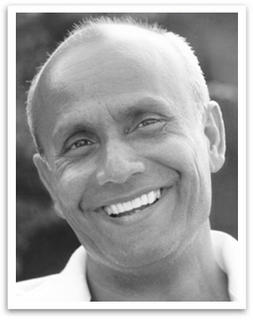Hello Hindustan with Kapil Krishnaswamy (15) - About guru Sri Chinmoy

Sri Chinmoy, a world-famous spiritual teacher, musician, artist, and prolific poet, is perhaps best known for his near-Herculean efforts to promote the ideals of peace and spiritual freedom on the world stage and for the impressive list of spiritual and political friends he has enlisted in these efforts, including Nelson Mandela, Mikhail Gorbachev, the last two popes, and a former Secretary General of the U.N.
But his accomplishments hardly stop there. A former decathlete and world-class long-distance runner, Sri Chinmoy has made the transcendence of human limitations his own personal sadhana [spiritual practice].

To hear his list of achievements and records—from creating more than sixteen thousand paintings in one twenty-four-hour period to writing over thirteen hundred books to lifting over seven thousand pounds—is to journey into a world in which normal ideas of what's possible seem to crumble away in the face of the love, devotion, and surrender that Sri Chinmoy cites as the source of his extraordinary talents.
But despite his impressive résumé of personal achievements, Sri Chinmoy's most extraordinary feat of all may be his near-miraculous ability to inspire in many of his students the same kind of limitation-shattering abilities that have marked his own spiritual odyssey, and his own accomplishments are perhaps only surpassed by the many accomplishments of those who have been inspired by his example, like Ashrita Furman.
The list of achievements of Sri Chinmoy is pretty amazing.
Art. He has painted these amazing acrylic abstract pieces, over 135,000, and they're just astounding. They're so beautiful. He doesn't use his mind at all. He says he follows a streak of light when he paints. And the colors! He doesn't choose them by any kind of mental choice, it's like an intuition—he dips his brush or his sponge or his fingers or however he's painting. He's very creative. The artwork is a perfect example of his creativity, because there's no end to what he has done. He says he's not worried about the quality, because he surrenders that to the Supreme. He's an instrument. So he's doing all of this not for his own glory or name and fame. He's doing it to inspire other people. He says that the Supreme has to take care of the quality, and he'll just produce. One time he wanted to see how many paintings he could do in twenty-four hours !
Literature. He's also written more than thirteen hundred books—poetry, aphorisms, plays, short stories. It's all coming from his inner realization and it's just endless. He doesn't stop. And he feels a tremendous inner push to keep writing and creating.
Once something really nice happened. He wrote a series of short poems. He said that some people were criticizing him because his poetry wasn't rhyming, so he decided to write a book of rhyming poems. He'd just written it and was very excited about it. He told each person who was there at his house to pick a number from one to one hundred—because he'd written about a hundred poems. Someone would pick a number, and then he'd turn to that page and read the poem. He got to me and I picked number twenty-three. The page was blank! So he wrote a poem right on the spur of the moment. He's so creative that on the spur of the moment, he'll just get the inspiration and create. Again, he doesn't think—he just goes deep within and it flows out.
Music. He has written thousands, literally, thousands of songs—beautiful, incredibly uplifting songs in his mother tongue, Bengali, and in English. And I've been to a concert where he's played more than a hundred musical instruments, and it's all self-taught. He's really the foremost expert on the esraj in the world. It's an Indian string instrument, like an Indian cello, you might say. It has all these sympathetic strings, so when he plays these notes, the other strings reverberate. It's very moving. He's played more than five hundred concerts around the world. They're free—they're always for free—to inspire people to go deep within and feel that peace within themselves.
Sports. Even his weight lifting is creative. He doesn't do things in the standard way. He wouldn't just sit down and see how much he could do on a bench press. He'd see what the heaviest elephant is that he could lift on the calf-raise machine. He has a whole program that he calls "Lifting Up the World", which is a beautiful concept. People stand up on a platform and he gets underneath, pushes up on a handle, and it lifts up the platform. He's literally lifting them up. It's a way of appreciating people. He's lifted more than four thousand people around the world doing this—people like Nelson Mandela—prime ministers, presidents, but also just people who are doing good things.
He was also a decathlete in India, and he was really a champion. He was a champion sprinter in
his ashram. Coming to the West, he actually was into long-distance running for a while.
Philosophy. One of the major pillars of his philosophy is self-transcendence, that there's no end to our progress. As far or as high as you go, you can always go higher. And that's on the spiritual realm, because the Supreme is infinite, there's no end. You just keep going. It's the same thing with everything that he does. So, on a physical plane as well, he inspires us to push ourselves in whatever we do.
We almost expect that he can do anything that he wants to do. And he's doing it to inspire us, to inspire people to transcend themselves. People are so limited by their minds. And he's just trying to say, "Okay, you've got to break out of that mental limitation."
Surrender to the will of the Supreme. In his case, he really has very close communication with the Supreme, and he is a surrendered instrument. He sometimes calls himself a football—the Supreme can just kick him in any direction that It wants to, and he's completely surrendered. Really, that's the only way he does any of this. It's not based on technique. Everything he does—his painting, playing musical instruments, everything—it's not any kind of fancy technique. It's all coming from his heart and from his soul. He's really an instrument, letting the divinity flow through him and create. He's trying to tell us that we can all do this if we can surrender, if we can get into that consciousness where we can overcome our own mind and other limitations, impurities, and be a pure instrument so the grace can flow through us.

0 Comments:
Post a Comment
<< Home